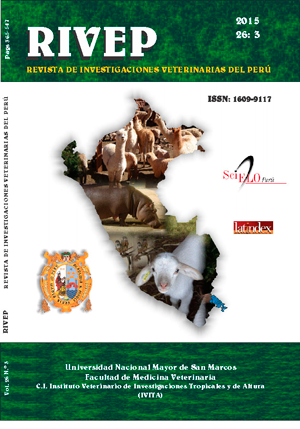Anatomical description of the sinus in the alpaca (Vicugna pacos)
DOI:
https://doi.org/10.15381/rivep.v26i3.11184Keywords:
alpaca, sinuses, anatomyAbstract
The objective of the present study was to describe the macroscopic anatomy of the sinus in the alpaca. Ten skulls of adult alpacas were prepared by the maceration technique, and the description through longitudinal cuts was done using terminology recommended by the Nomina Anatomica Veterinaria. In addition, X-rays with contrast medium were taken to four adult alpacas to determine the relationships of sinus with other anatomical structures. Results showed that the frontal and maxillary sinus were well developed and communicated through the frontomaxillary hole; the frontal sinus is divided into a medial and lateral portion as in small ruminants; the maxillary sinus is undivided and has a communication with the nasal cavity through the nasomaxillary opening as in the equine. The sphenoid and ethmoid sinuses were not evident.Downloads
Downloads
Published
Issue
Section
License
Copyright (c) 2015 Rosse Zárate L., Miluska Navarrete Z., Alberto Sato S., Diego Díaz C., Wilfredo Huanca L.

This work is licensed under a Creative Commons Attribution-NonCommercial-ShareAlike 4.0 International License.
AUTHORS RETAIN THEIR RIGHTS:
a. Authors retain their trade mark rights and patent, and also on any process or procedure described in the article.
b. Authors retain their right to share, copy, distribute, perform and publicly communicate their article (eg, to place their article in an institutional repository or publish it in a book), with an acknowledgment of its initial publication in the Revista de Investigaciones Veterinarias del Perú (RIVEP).
c. Authors retain theirs right to make a subsequent publication of their work, to use the article or any part thereof (eg a compilation of his papers, lecture notes, thesis, or a book), always indicating the source of publication (the originator of the work, journal, volume, number and date).










